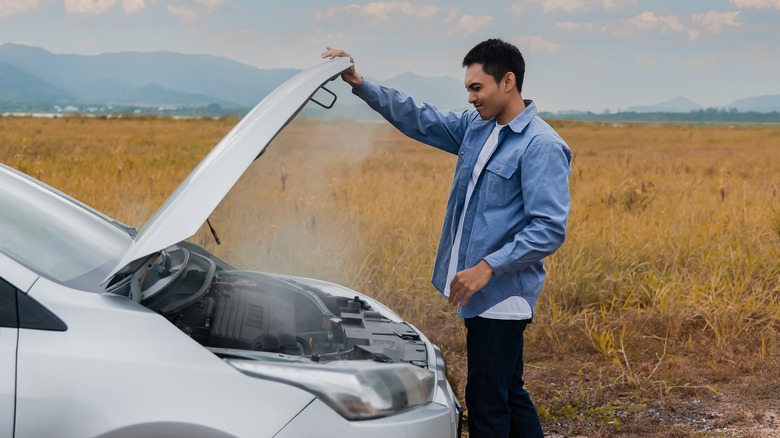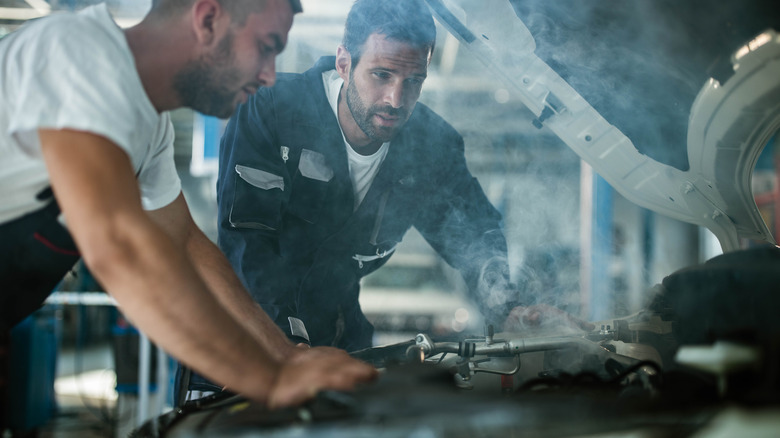If Your Car's Engine Starts Overheating, Here Are The First Things You Need To Do
For many, having a vehicle readily available is essential for everyday life — whether it's going to work, taking the kids to school, running errands, or chipping away at your road trip bucket list. In order to do these things, your vehicle requires regular maintenance, such as changing your oil, rotating your tires, replacing brakes, among other things. However, sometimes your vehicle needs more than regular maintenance, and you won't know something is wrong until a warning light pops up on your dash.
This may mean that the check engine light comes on, and you simply need to change a sensor. Then, there are more extreme issues like an engine overheating. An overheating engine can be caused by a number of reasons, such as driving for long periods on a hot day, stuck or a bad thermostat, a coolant leak, a faulty water pump, low oil levels, or a malfunctioning fan clutch –- to name a few.
The problem with an overheating engine is that if it's undermined, then you could be looking at high repair costs or, worse, a blown engine. It may seem odd, but if you see your thermostat creeping into the red or the engine temperature warning light comes on, don't keep driving to the nearest mechanic. Instead, do these things first.
What to do
In addition to the engine temperature gauge spiking into the red or hitting "H," there are other tell-tale signs that you have a problem. You may also notice steam coming from under the hood, a sweet smell (coolant leak), or a burnt smell (oil leak). When this happens, you should immediately turn off the air conditioner (if it's on) and turn the heater on max.
You may be reluctant to do this, especially if it's hot outside, but this is a vital step in protecting your engine from damage. Turning the air conditioner off reduces stress on the engine, and turning the heater on pulls heat away from the engine.
Next, it's important to find a safe place to pull over. Once in a secure spot, turn off the vehicle, turn on your hazard lights, and set out emergency cones if you have an emergency kit. Let your engine cool down for at least 15 minutes, but the longer, the better. While waiting, start planning on getting your vehicle checked out by a certified mechanic. The best strategy is to either have a tow truck take your vehicle to the nearest repair shop, or if you have a friend who has a trailer, you can go that route too. Having a membership to AAA or calling your auto insurance provider to see if you have roadside assistance can come in handy in this situation because tow companies aren't cheap.
If you aren't able to get a tow truck or a friend to help –- especially if you don't have cell service –- you can restart the engine and cautiously drive to the nearest repair shop. Be sure to watch the temperature gauge, and if it overheats again, repeat the aforementioned process.
What not to do
Now that you know what to do when your engine overheats, there are things to avoid, too. First, don't panic, and remain calm. Take the time to find a safe spot to pull over, especially if you are driving on the interstate or highway. It may also be tempting to open the hood right after pulling over, but refrain from doing this. The build-up of steam could potentially cause burns or other injuries.
Also, it's critical not to ignore the problem. An overheating engine is serious and could mean repairing a head gasket, buying a replacement engine, or a new vehicle if the problem is not addressed. Even if it seems like the issue was fixed after adding coolant, it's best to get an inspection, just to be sure.
Lastly, there are ways to prevent an overheating engine altogether. Sticking with the recommended service intervals can be the difference between making it to your destination and being stranded. Every so often, have a complete inspection done on your engine, radiator, fluids, and other vital components.


